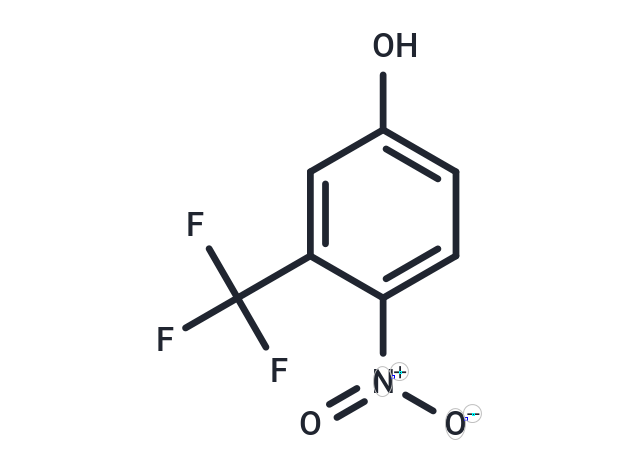- Remove All
 Your shopping cart is currently empty
Your shopping cart is currently empty
Shopping Cart
TFM
Catalog No. T37632Cas No. 88-30-2
TFM is a piscicide.1It is toxic to sea lamprey (P. marinus) with LC50values ranging from 1.97 to 2.11 and 2.05 to 2.21 mg/L for sac and swim-up fry, respectively, 1.6 to 2.45 mg/L for juveniles, and 1.6 to 1.63 mg/L for adults. It is also toxic to juvenile lake sturgeon (A. fulvescens) less than 100 mm in size but not to a variety of other fish species. TFM (50 μM) uncouples oxidative phosphorylation by 22 and 28% in isolated sea lamprey and rainbow trout (O. mykiss) liver, respectively.2Formulations containing TFM have been used as lampricides in the control of larval sea lamprey populations.

TFM
Catalog No. T37632Cas No. 88-30-2
TFM is a piscicide.1It is toxic to sea lamprey (P. marinus) with LC50values ranging from 1.97 to 2.11 and 2.05 to 2.21 mg/L for sac and swim-up fry, respectively, 1.6 to 2.45 mg/L for juveniles, and 1.6 to 1.63 mg/L for adults. It is also toxic to juvenile lake sturgeon (A. fulvescens) less than 100 mm in size but not to a variety of other fish species. TFM (50 μM) uncouples oxidative phosphorylation by 22 and 28% in isolated sea lamprey and rainbow trout (O. mykiss) liver, respectively.2Formulations containing TFM have been used as lampricides in the control of larval sea lamprey populations.
| Pack Size | Price | Availability | Quantity |
|---|---|---|---|
| 50 mg | Inquiry | 35 days | |
| 100 mg | Inquiry | 35 days |
Bulk & Custom
Add to Cart
Questions
View MoreContact us for more batch information
Resource Download
Product Introduction
Bioactivity
Chemical Properties
| Description | TFM is a piscicide.1It is toxic to sea lamprey (P. marinus) with LC50values ranging from 1.97 to 2.11 and 2.05 to 2.21 mg/L for sac and swim-up fry, respectively, 1.6 to 2.45 mg/L for juveniles, and 1.6 to 1.63 mg/L for adults. It is also toxic to juvenile lake sturgeon (A. fulvescens) less than 100 mm in size but not to a variety of other fish species. TFM (50 μM) uncouples oxidative phosphorylation by 22 and 28% in isolated sea lamprey and rainbow trout (O. mykiss) liver, respectively.2Formulations containing TFM have been used as lampricides in the control of larval sea lamprey populations. 1.Boogaard, M.A., Bills, T.D., and Johnson, D.A.Acute toxicity of TFM and a TFM/niclosamide mixture to selected species of fish, including lake sturgeon (Acipenser fulvescens) and mudpuppies (Necturus maculosus), in laboratory and field exposuresJ. Great Lakes Res.29(Suppl 1)529-541(2003) 2.Birceanu, O., McClelland, G.B., Wang, Y.S., et al.The lampricide 3-trifluoromethyl-4-nitrophenol (TFM) uncouples mitochondrial oxidative phosphorylation in both sea lamprey (Petromyzon marinus) and TFM-tolerant rainbow trout (Oncorhynchus mykiss)Comp. Biochem. Physiol. C. Toxicol. Pharmacol.153(3)342-349(2011) |
| Molecular Weight | 207.11 |
| Formula | C7H4F3NO3 |
| Cas No. | 88-30-2 |
Storage & Solubility Information
| Storage | Powder: -20°C for 3 years | In solvent: -80°C for 1 year | Shipping with blue ice. | ||||||||||||||||||||||||||||||||||||||||
| Solubility Information | Ethanol: 30 mg/mL (144.85 mM), Sonication is recommended. PBS (pH 7.2): 5 mg/mL (24.14 mM), Sonication is recommended. DMSO: 30 mg/mL (144.85 mM), Sonication is recommended. DMF: 30 mg/mL (144.85 mM), Sonication is recommended. | ||||||||||||||||||||||||||||||||||||||||
Solution Preparation Table | |||||||||||||||||||||||||||||||||||||||||
PBS (pH 7.2)/Ethanol/DMSO/DMF
Ethanol/DMSO/DMF
| |||||||||||||||||||||||||||||||||||||||||
Calculator
In Vivo Formulation Calculator (Clear solution)
Please enter your animal experiment information in the following box and click Calculate to obtain the mother liquor preparation method and in vivo formula preparation method:
Mother liquor preparation method: 2 mg of drug dissolved in 50 μL DMSO (mother liquor concentration of 40 mg/mL), if you need to configure a concentration that exceeds the solubility of the product, please contact us first.
(mother liquor concentration of 40 mg/mL), if you need to configure a concentration that exceeds the solubility of the product, please contact us first.
Preparation method for in vivo formula: Take 50 μL DMSO main solution, add 300 μLPEG300
main solution, add 300 μLPEG300 mix well and clarify, then add 50 more μL Tween 80, mix well and clarify, then add 600 more μLddH2O
mix well and clarify, then add 50 more μL Tween 80, mix well and clarify, then add 600 more μLddH2O mix well and clarify
mix well and clarify
For Reference Only. Please develop an appropriate dissolution method based on your laboratory animals and route of administration.
Dose Conversion
You can also refer to dose conversion for different animals. More Dose Conversion
Tech Support
Please see Inhibitor Handling Instructions for more frequently ask questions. Topics include: how to prepare stock solutions, how to store products, and cautions on cell-based assays & animal experiments, etc
Keywords
Related Tags: buy TFM | purchase TFM | TFM cost | order TFM | TFM chemical structure | TFM formula | TFM molecular weight

Copyright © 2015-2025 TargetMol Chemicals Inc. All Rights Reserved.




